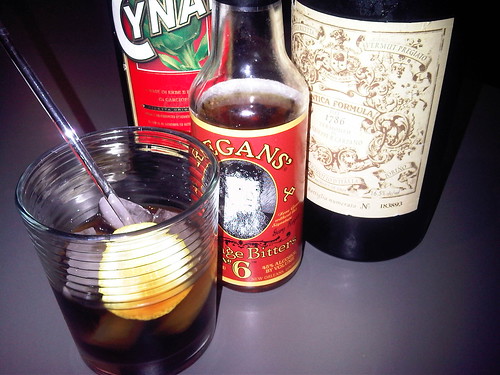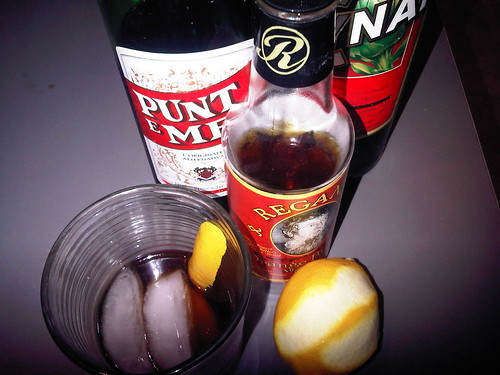Most nights I make cocktails for two, but when my husband is out of town I almost always reach for the amari (he is not a bitter lover and that is an understatement). Campari, Cynar, Fernet-Branca – it’s all fair game, and the more bitter the better as far as I am concerned (I wonder, is there such a thing as a bitterness scale for amari, similar to IBUs for beer?).
Last night, I decided to try a riff on a Cynar + sweet vermouth combination, Christian Siglin’s Milano Swizzle.

Build in glass | 1 oz London dry gin | 1 oz Cynar | 1 oz sweet vermouth | 1/4 oz lemon juice | pinch kosher salt | add crushed ice, swizzle | lemon peel garnish
(On the side: zahtar + sumac almonds)
The inspiration for the drink started with the Bitter Giuseppe from rogue beta cocktails, a drink combining Cynar with Carpano Antica sweet vermouth and orange bitters. As its name indicates, it is quite bitter.

It starts becoming interesting when you add salt, because you don’t really taste the salt but you end up changing the character of the drink from intensely start-to-finish bitter to a bitter entry with an unexpected savory/umami finish. The Search for Delicious, also from rogue beta cocktails, is essentially the Bitter Giuseppe with a pinch of salt.
There is a really nice discussion on the role of salt in cocktails on the beta cocktail blog (the Campari “martini”). To summarize, salt is more efficient than sugar at masking bitterness. Additionally, it has the ability to bring out sweetness in foods or drinks. Hervé This discusses this in Molecular Gastronomy: Exploring the Science of Flavor. He describes an experiment in which adding a pinch of salt to Schweppes tonic water increased the perception of sweetness while diminishing the bitterness of the quinine that is present in tonic water. The exact mechanism for this is unknown; however this effect has practical implications and can be used to enhance cocktails.
This all leads us back to the Milano Swizzle, which is uses the same foundation as the Search for Delicious (including the salt), with the addition of London dry gin. It has the bitter character of the Cynar. The salt seems to bring out additional layers of flavor from the Cynar, increasing flavor as a whole. As a bonus, the savory finish of the drink makes you go for more.
This makes me think that I need to revisit my old favorite, the Negroni, with a pinch of salt and see what happens…

Search for delicious is just amazing.
Like drinking grown-up creme de cacao!
I am with you; it is quite spectacular!
Pingback: Fatigue | Tartines to Tikis